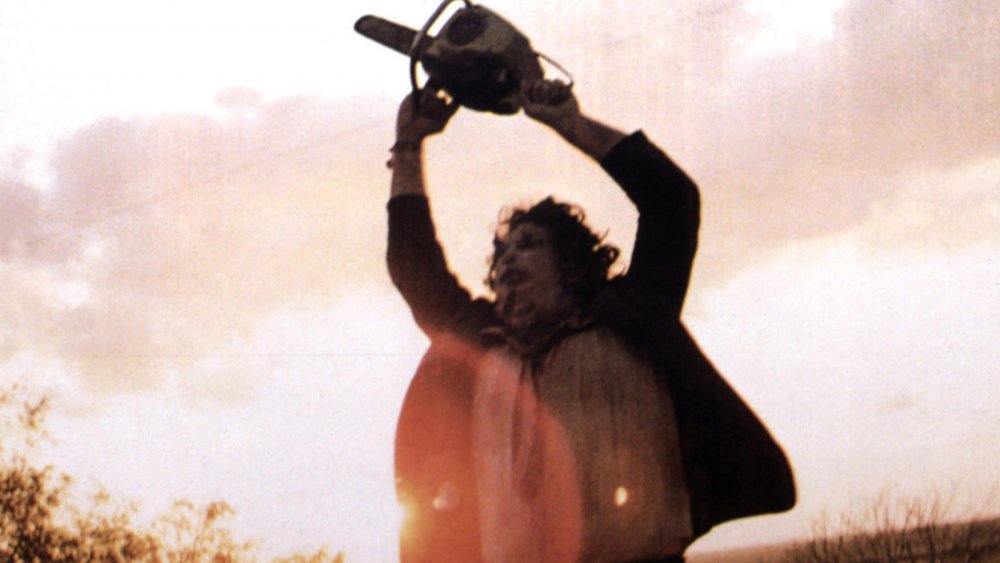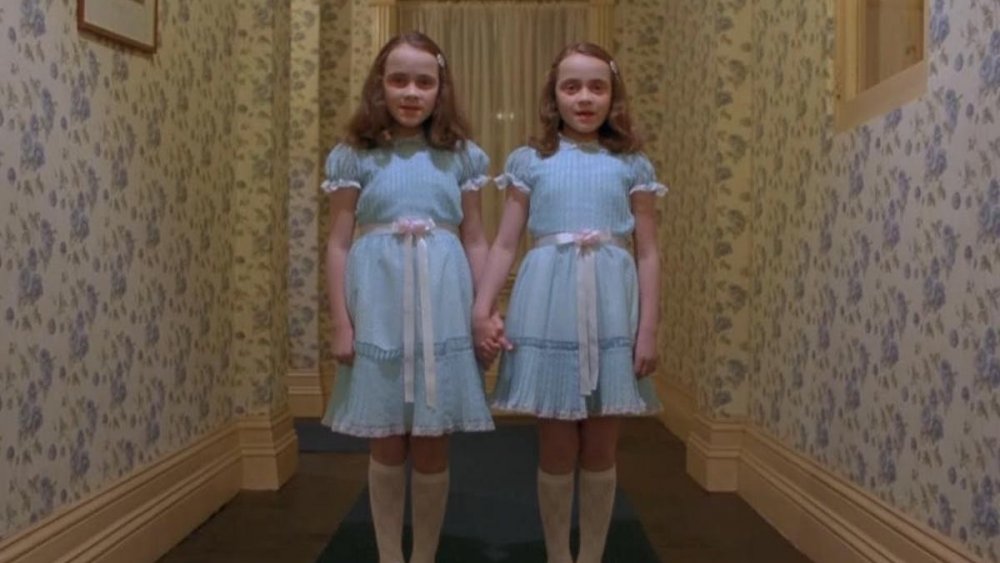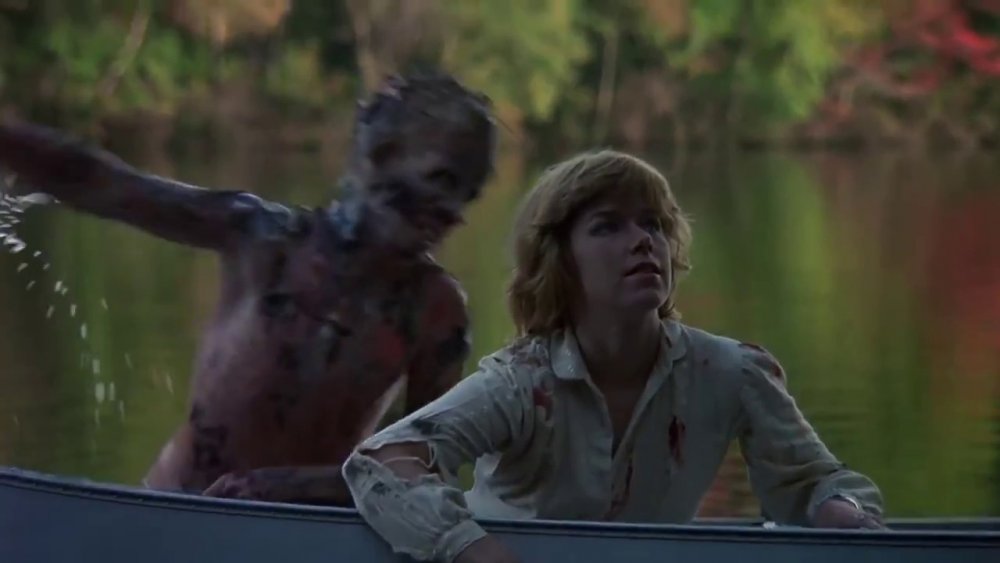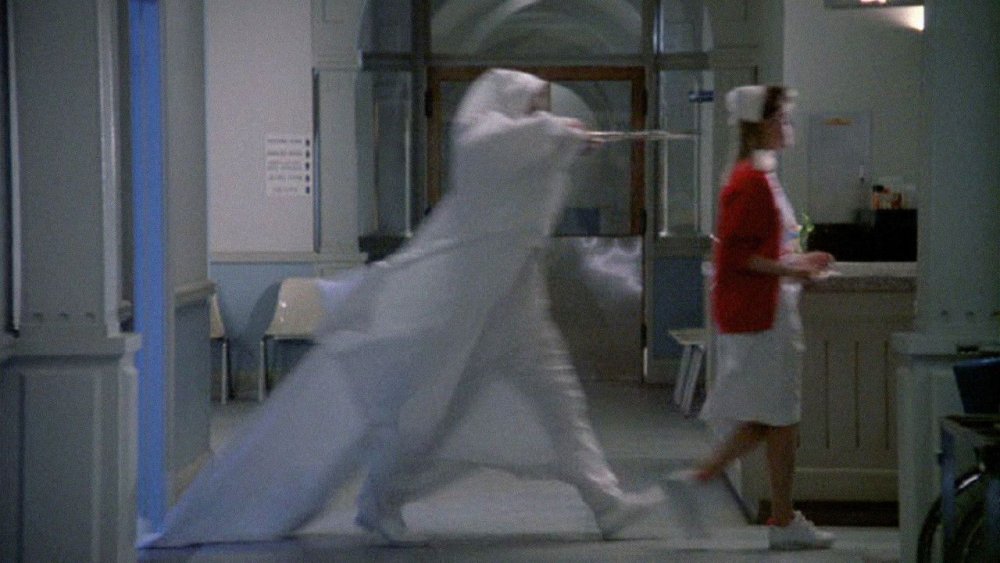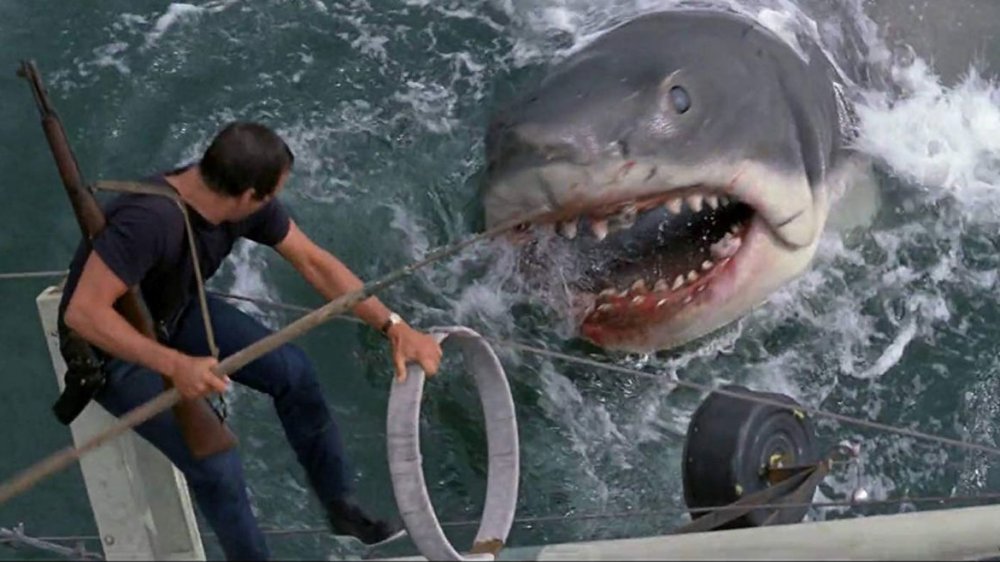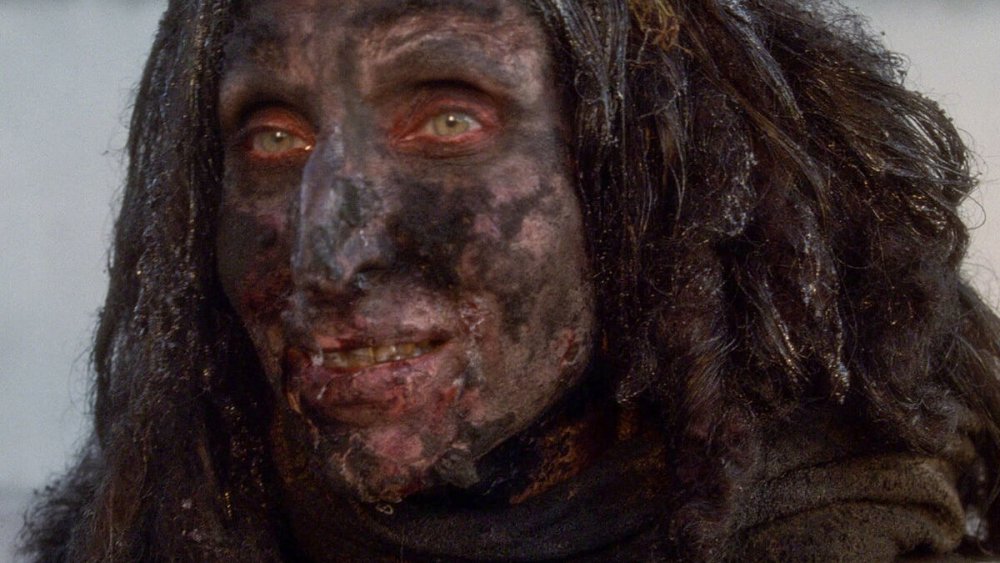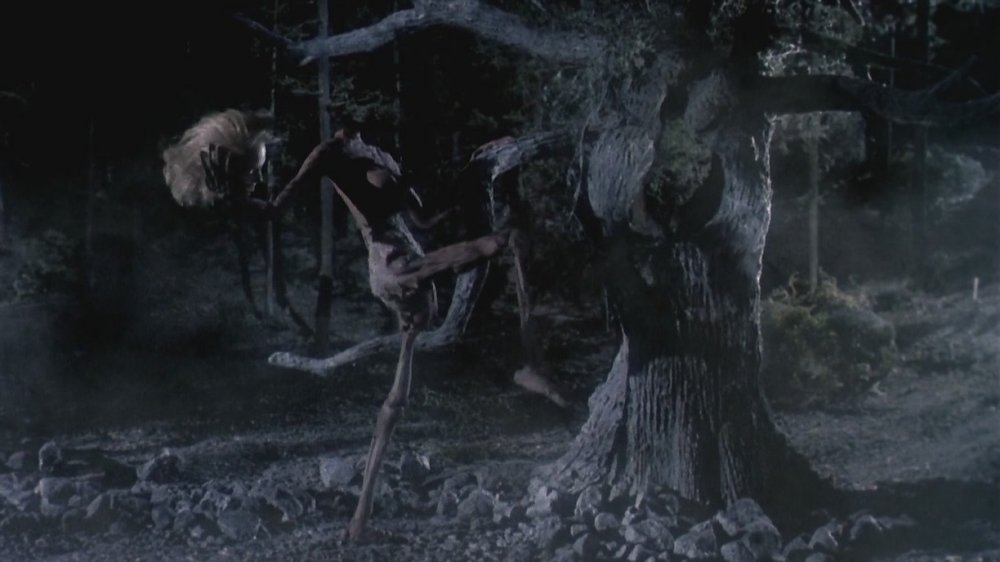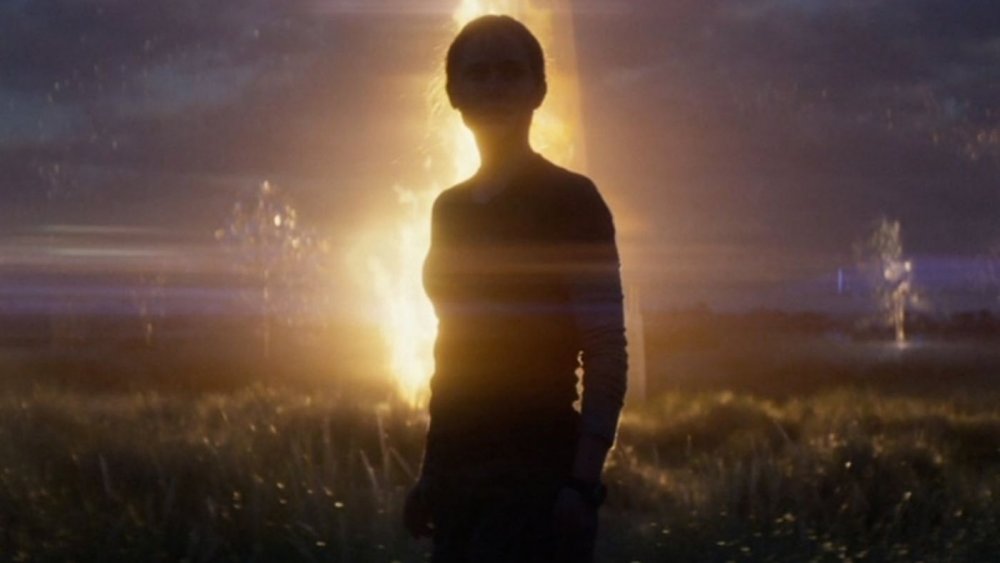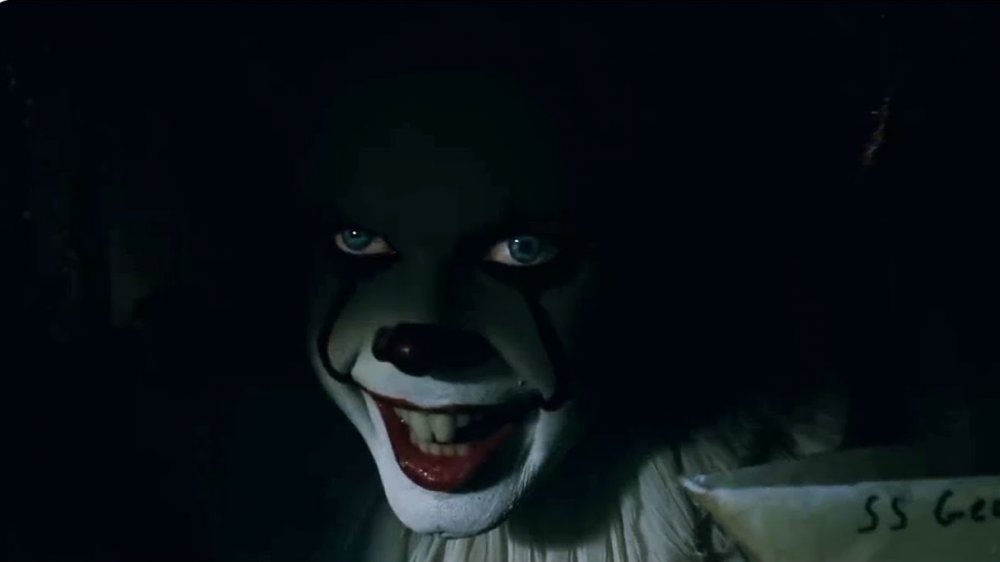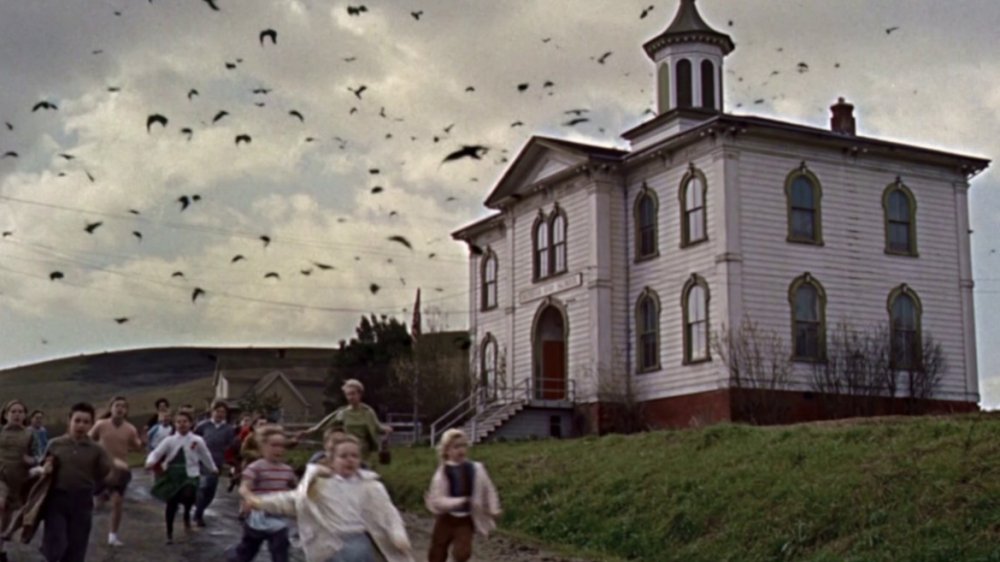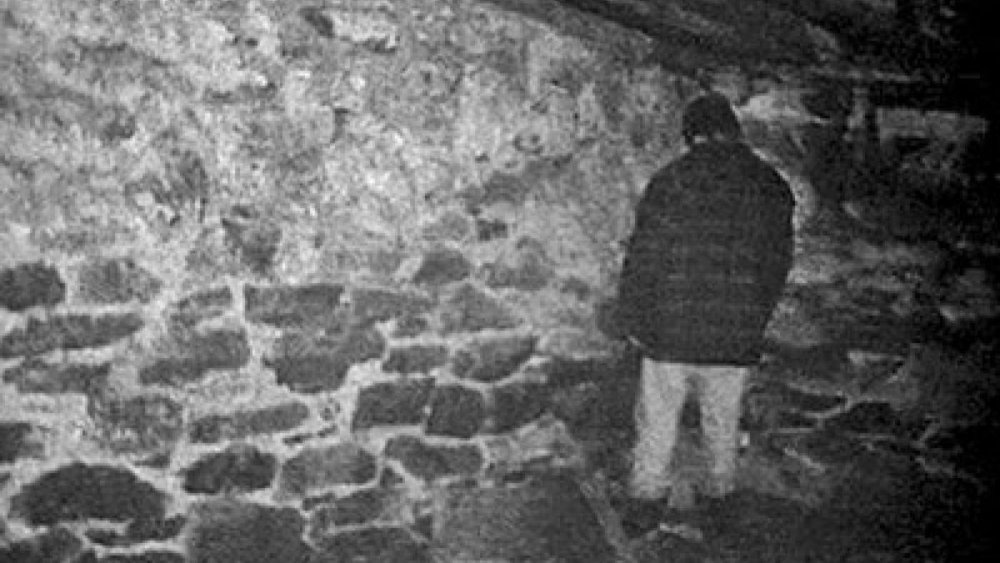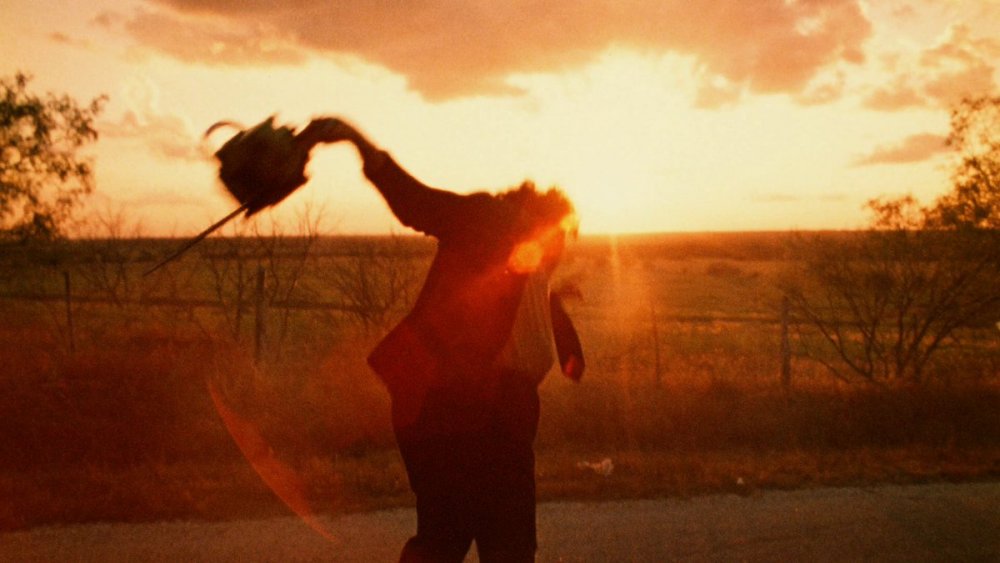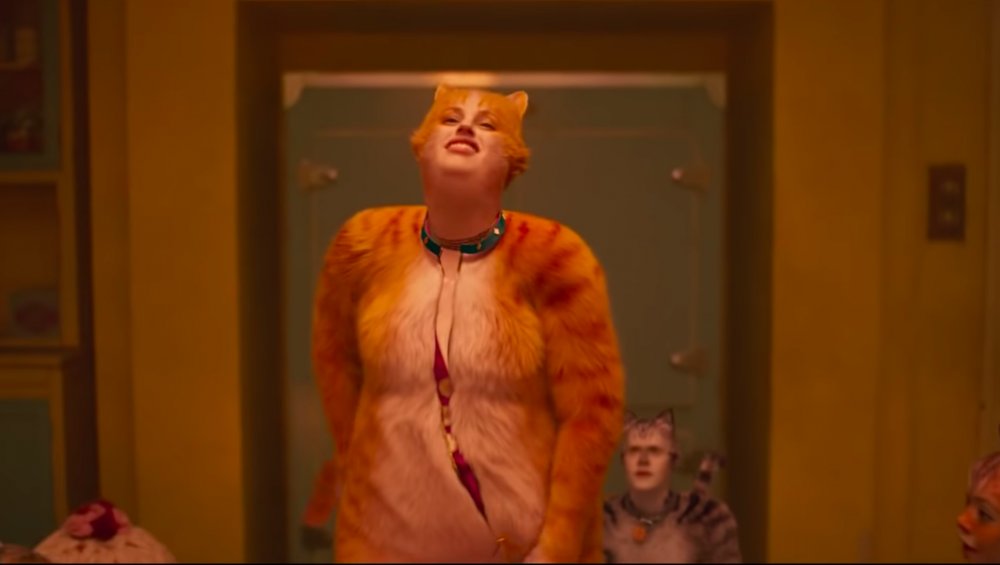Single Shots From Movies That Will Haunt Us Forever
Horror stories exist in every medium you can use to tell them, but there's a reason the genre's done so well in the movies. Before the technology existed to project moving pictures, horror could exist in narrative or images, but not both at once. In movies, we can follow the stories of the things we're afraid might happen to us, right along with images that often seem to have been picked right out of our nightmares — and that makes them stick with us in a way few other media can. Some of the images on this list have taken up residence in our minds even if we haven't seen them in years. Some of them are so powerful, they may haunt us even if we've only absorbed them from the wider pop culture without ever seeing them in context. Others need to catch you by surprise for you to get the full effect, so know that this article is full of spoilers. With that out of the way, let's get started with this look at the shots that will haunt us forever.
The two sisters - The Shining
We'll start right off with one of the most iconic shots in horror history, and maybe any movie in any genre. Stanley Kubrick's adaptation of Stephen King's novel The Shining pits Jack Nicholson, Shelley Duvall, and Danny Lloyd, as their son Danny, against the ghosts who haunt the Overlook Hotel. The spirits had previously driven another caretaker into a homicidal rage, murdering his wife and two daughters.
As Danny explores the empty hotel on his Big Wheel trike, he turns a corner and suddenly sees the two sisters staring him down from across the hall. Even before we see brief flashes of their hacked-up bodies, the straight-ahead shot of the girls looking directly into the audience is terrifying. Kubrick cast the Burns twins on the suggestion of his longtime assistant, Leon Vitali, who also suggested a famous photo by the great fine art photographer Diane Arbus as inspiration for the scene.
The hotel manager says that the dead children weren't actually twins: one was eight, and the other was ten. As Roger Ebert points out, though, that only adds to the sideways nightmare logic of the movie. So do their British accents (the movie takes place in the Rocky Mountains). One of Kubrick's major departures from King's novel was casting doubt on whether anything we see is real, and shots like this make it clear that even if it is, it's deeply, horribly surreal.
Jason returns - Friday the 13th
The original Friday the 13th may be a surprise for viewers expecting it to be like its countless sequels. It's much slower paced. The victims are less deserving. And strangest of all, the series' icon Jason Voorhees isn't in it... until the very end.
In the movie's final minutes, we learn that the mysterious figure killing teenagers at Camp Crystal Lake is Pamela Voorhees, out for revenge after the camp counselors failed to save her son Jason from drowning decades earlier. After a long struggle, Pamela's final victim, Alice Hardy, kills her and escapes in a canoe. We next see her at sunrise the following day. The sky and lake look golden and gorgeous. The police are on the opposite shore, ready to rescue Alice and clean up Pamela's mess. We cut to a shot of Alice lying relaxedly in the boat. It seems like all her troubles are over. Then suddenly, Jason's rotting corpse jumps out of the lake where he'd drowned all those years ago and drags Alice down with him. It was a shocking twist that caught audiences off guard in 1980, and even though it turned out to be a dream, this classic jump scare paved the way for Jason's franchise-leading role in subsequent installments.
Stalking the nurse - The Exorcist III
In The Exorcist III, a series of murders suggest that a serial killer known as "the Gemini" has returned. But the killer had been executed 15 years earlier, and the new murders recreate details that only the police and the Gemini himself could have known. It turns out that the murderer has been recruited by the powers of hell, who have given him possession of Father Damien Karras' body to get revenge after he defeated them in the original Exorcist, and the Gemini's continued picking off victims from his cell in a hospital basement.
This haunting shot takes a lot of its power from the scene leading up to it. We watch a nurse working the graveyard shift in the hospital above the Gemini killer's cell. For a long time, nothing happens, but we're sure something will. There's noises of someone moving around, and every sound makes the nurse (and us) jumpy. When she investigates, there's a decoy jump scare as she accidentally wakes up a patient. Just when it seems like nothing will happen after all, that figure in the white sheet appears, out of nowhere and without warning. The camera jerks us awake as it zooms in, the music blares — and the scene immediately ends, coming and going as quickly as a punch to the gut. We don't actually see what happens afterwards, but from the police description, it's so horrible we might not have been able to handle it.
The floating corpse - Jaws
Directed by the young Steven Spielberg, Jaws focuses less on shock effects than developing character and atmosphere as the dread slowly builds. A lot of that was out of necessity — it really was filmed in the open ocean, and the animatronic shark broke down so much that Spielberg had to use it sparingly. But it also means that when the big shocks do land, they land hard.
At this point in the movie, a team of fishermen have gone out to kill the shark that's been terrorizing the beach town of Amity. When the movie's heroes, Hooper and Brody, discover the remains of the fishermen's boat out at sea, Hooper dives in to investigate. While he's collecting a tooth the shark left behind, one of the fishermen's corpses suddenly drifts out into his face. It's an all-time classic jump scare, but the next shot's even more horrifying. It plays on our fear of the dark, with nothing but the corpse's pale face visible in the nighttime water, illuminated by Hooper's flashlight. That also forces us to look right at it, and it's not a pretty sight. After days at sea, the corpse is horribly deformed, its mouth hanging open at an unnatural angle, and one eye almost pops out of its head as if it's staring right at you.
The man behind Winkie's - Mulholland Dr.
After the success of Twin Peaks, creator David Lynch put together a pilot for a new spinoff. When he couldn't sell it, he turned the script into Mulholland Dr. In the process, he didn't just adapt the main story; he also included the interludes with other characters that would have set up future plots. As a result, Mulholland Dr. is a strange film that twists in and out of back alleys and dead ends that branch off from the main story, creating little mini-movies within the larger whole and raising questions with no clear answers. Most of them never affect the main story in any obvious way, but they're all memorable in their own right — especially the scene in Winkie's diner.
Two men sit in a booth as one of them describes his recurring nightmare where they're in Winkie's, when he sees some horrible, sinister figure hiding behind it. His friend suggests they go out and confirm it's just a dream. The scene is already tense and nightmarish even before we find out it isn't — traffic noise and a loud, unearthly hum drown out their dialogue. Then the creature from the nightmare jumps out like a jack-in-the-box. The man was right to say "I hope that I never see that face, ever, outside a dream." It's so horribly burned it's barely human, with an expression that suggests it's plotting something awful. It's lingered in moviegoers' memories for years.
Corpse ballet - Evil Dead 2
With his no-budget horror classic The Evil Dead, director Sam Raimi funneled all his limited resources into a no-frills, non-stop scare delivery system. When it attracted the attention of superproducer Dino DeLaurentiis, Raimi created The Evil Dead 2, a remake of the first with more tonal complexity. He made the horror elements so over-the-top they worked as slapstick comedy. And in many scenes, like one when the entire house comes to life to laugh at the hero, the jokes and scares feed each other.
This shot is another example. As Ash, Bruce Campbell has accidentally released an ancient evil by playing back tapes of an archaeologist reading spells from the Book of the Dead. This turns his girlfriend into a monstrous "Deadite," and Ash is forced to slice off her head with a shovel. He buries her, but the next night, the body claws its way back out of the grave, reattaches its head, and puts on a little dance for Ash.
Even with DeLaurentiis' support, Raimi still couldn't afford especially realistic effects, but he knew how to use the effects he could afford to their maximum potential. The corpse is animated in stop motion, and the inherent unnaturalness of the medium and the inhumanly skinny limbs make this shot even creepier as the corpse dances around. Adding to the nightmare fuel, the head is modeled in much more detail than the cartoony body and remains eerily motionless as the rest of the corpse dances around.
The videotape - Annihilation
Annihilation's story of an alien presence that warps the "Shimmer" where it landed isn't just horrifying — it's downright traumatizing. There are dozens of shots we could point to, many of them equally horrible and beautiful. But this one is particularly haunting.
A team of scientists led by Natalie Portman is exploring the Shimmer and hopefully learn what happened to the last group to go in there, including the Portman character's husband, played by Oscar Isaac. In Isaac's abandoned base, they find a zip-loc bag with a memory card and the message "For those that follow." They insert the memory card into a camera and watch the video their predecessors left behind. It includes a shot of Isaac cutting a man's stomach open, and it probably says something that it isn't even the scariest one.
In this shot, we see that the Shimmer has brought the man's intestines to life, and we watch as they slither like slimy eels around Isaac's hand. Many filmmakers have preyed on what they call "body horror," the fear that we might be threatened not from outside but within ourselves, turning the reality of our bodies breaking down and failing us into horrible new forms. Few have done it better than this, and what we hear is almost as scary as what we see, with Geoff Barrow and Ben Salisbury composing an eerie score that sounds like something between mechanical droning and a choir of human voices.
Pennywise in the sewer - It: Chapter One
Another Stephen King adaptation, It arrived in theaters with high expectations. One question in particular was on a lot of people's minds: Could Bill Skarsgård hope to be as scary in the role of the fear-eating monster as Tim Curry was in the '90s TV miniseries? The first trailer put those doubts to rest with this terrifying image of It, as Pennywise the Clown, luring a child to its death in the sewers.
This shot exploits the universal fears of the unknown and the dark, with only a sliver of Pennywise's face visible in the shadow of the drain. And like Evil Dead 2, It exploits our uneasiness about things that are subtly wrong in ways we might not be able to identify right away. Glowing-eyed monsters are nothing new, but It uses a subtler, creepier effect, as if Pennywise's eyes had been dropped in from a daylight scene. And if you look closely at those eyes, you'll notice something else: They're out of sync with each other, and while one is looking at Pennywise's victim, the other seems to be looking right at you. And as Bill Hader found out the hard way, that's not a special effect!
Pecked-out eyes - The Birds
Alfred Hitchcock's classic chiller The Birds takes a while to reveal it's a horror movie. For the first several scenes, it seems to be a romantic comedy about Tippi Hedren as a pet shop clerk who schemes to get Rod Taylor alone at his isolated home in Bodega Bay. But when the horror comes, it comes in fast and furious. The bay is attacked without warning by thousands of birds, and it's even scarier because we never know why.
In the most harrowing scene, Jessica Tandy, as the Taylor character's mother, discovers just how deadly the birds are when she goes to visit her neighbor. She knows something is wrong because she can't hear him anywhere in the house: while Hitchcock's movies are famous for their dramatic, or even over-dramatic musical scores, this shot and the scene it takes place in are all the creepier for their eerie silence. There are actually three shots here, each one moving closer to the dead man's disfigured face and each less than a second. They're timed perfectly: Long enough to register the horror of what we're seeing, but too short for the shock to wear off before the movie goes racing to the next scare.
Time out - The Blair Witch Project
The Blair WItch Project was one of the first found footage movies, presented as the real recordings of documentary filmmakers Heather, Mike, and Josh, who disappear into the woods of Connecticut to investigate the legendary witch. By the end, Josh has disappeared, and the other two follow his screams to an abandoned house, where they get separated. Heather finds Mike standing facing the wall. Attentive viewers will know what's about to happen even before we cut to the next shot. The movie begins with interviews with locals about the legends of the Witch, and one of them mentions that she forced children to face the wall as they waited their turn to die.
The shadowy lighting is part of what makes this shot so haunting. Part of the reason everyone's afraid of the dark is an instinct from millions of years of experience that if we can't see what's going on, there might be something out to get us. The grainy, black-and-white footage makes it even creepier: We can tell what we're looking at, but it's just indistinct enough to trigger that fight-or-flight instinct. And the light from the camera's single flashlight is creepy in another way. It's obviously an amateur setup, and even though we've known this was only a movie for years, it still makes the scene feel real and immediate in a way that other found footage movies have been trying to recreate ever since.
Sunrise - The Texas Chain Saw Massacre
The Texas Chainsaw Massacre may well be the scariest movie ever made. It's certainly one of the most influential, redirecting horror from the supernatural into the gorier, nastier subgenre of slasher films. It's full of shots we could point to, from the blood-red room where the murderous Leatherface first appears, to the extreme close-up of his victim's bloodshot eye, to the surreal furnishings of his house, made of human and animal remains. But it saves its most haunting moment for last.
While most horror movies work on a system of tension and release, from the moment Texas Chainsaw Massacre's cast of helpless teenagers wander into Leatherface's home, the shocks don't let up for a second. In the end, the last survivor, Sally Hardesty, has finally managed to escape in the back of a passing truck. But we don't end with her. Instead, the last shot focuses on Leatherface, spinning his chainsaw around at random in a kind of graceless dance. Director Tobe Hooper shows his skill with light and color through the whole movie, and it's especially important here, with the camera pointed directly at the rising sun, turning everything a vivid, hellish orange. And then he throws out all the rules of editing to catch us off guard, smashing to black with Leatherface mid-swing and cutting off the relentless buzzing of the chainsaw mid-note. The result is as shocking as being woken up while you're still dreaming, and it can leave you deeply unsettled even after the movie ends.
Rebel Wilson unzips her skin - Cats
Some images only become more haunting because they were never supposed to be, and there are few examples better than Cats. As soon as the first trailer dropped, the reaction to these supposedly lovable human-faced kitties was sheer and universal horror.
This shot of Rebel Wilson as the Gumbie Cat is extra haunting because it comes right after a series of other bizarre moments: She holds some fleshy pink thing that was apparently supposed to stand in for her tail on-set but was never animated over, we're introduced to a cast of mice and cockroaches whose faces seem to float around on their heads, and since they're played by human actors, it seems more than a little like cannibalism when Wilson eats them. After all that, you'd expect a chance to catch your breath, but the movie cuts right from the bugs to Wilson unzipping her chest, and the next thing you know, her skin peels right off. Like a lot of Cats, it's the kind of thing that works on stage where the actors are obviously just wearing costumes but becomes intensely disturbing with the hyperrealistic "digital fur technology." One viewer watched it expecting cartoon physics and compared the reality to "an anvil dropping on a real bunny."
Purposely or accidentally, all of these shots have burrowed their way into our consciousness, and they're likely to stay there a long time.
